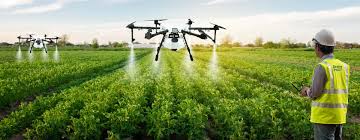The Potential of Drone Technology in Agriculture
Overview
Drone technology is poised to revolutionize Indian agriculture by offering innovative solutions to age-old farming challenges. With advancements in drone technology, farmers can now leverage aerial imagery, data analytics, and precision agriculture techniques to enhance productivity, optimize resource utilization, and increase crop yields.
Understanding the Impact of Drones in Agriculture
Enhanced Crop Monitoring
Drones equipped with high-resolution cameras and sensors enable farmers to monitor crop health, detect pest infestations, and identify nutrient deficiencies with unprecedented accuracy and efficiency.
Precision Agriculture
By precisely mapping field boundaries, soil characteristics, and crop growth patterns, drones empower farmers to make data-driven decisions regarding irrigation, fertilization, and pesticide application, leading to optimal resource allocation and cost savings.
Timely Intervention
Real-time aerial surveillance provided by drones allows farmers to detect early signs of crop stress, disease outbreaks, or adverse weather conditions, enabling timely intervention and preventive measures to mitigate crop losses.
Advantages of Drone Technology in Indian Agriculture
Increased Efficiency
Drones automate labor-intensive tasks such as crop scouting and field mapping, freeing up valuable time and resources for farmers to focus on strategic planning and decision-making.
Cost-Effectiveness
The use of drones reduces the need for manual labor, minimizes input costs, and maximizes crop yields, resulting in significant cost savings for farmers in the long run.
Environmental Sustainability
By enabling targeted application of inputs and minimizing chemical usage, drones promote sustainable farming practices, reduce environmental impact, and contribute to the conservation of natural resources.
Challenges and Opportunities
Challenges
- Regulatory Hurdles: Regulatory frameworks governing the use of drones in agriculture need to be streamlined to facilitate widespread adoption and integration into existing farming practices.
- Technical Limitations: Limited access to affordable drone technology, lack of technical expertise, and connectivity issues in rural areas pose challenges to the adoption of drones in Indian agriculture.
Opportunities
- Capacity Building: Investments in training programs, skill development initiatives, and technology transfer partnerships can equip farmers with the knowledge and resources to harness the full potential of drone technology.
- Collaborative Efforts: Public-private partnerships, collaboration between government agencies, research institutions, and technology providers are essential to drive innovation, address challenges, and accelerate the adoption of drones in Indian agriculture.
Paving the Way for Sustainable Agriculture
Drone technology holds immense promise for revolutionizing Indian agriculture and ushering in a new era of sustainable farming practices. By leveraging the capabilities of drones, Indian farmers can overcome traditional constraints, optimize resource management, and enhance agricultural productivity to meet the growing demands of a rapidly evolving food ecosystem.




